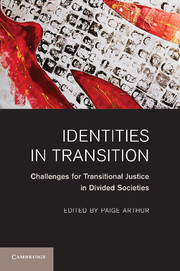Book contents
- Frontmatter
- Contents
- Acknowledgments
- Author Bios
- Introduction: Identities in Transition
- PART I IDENTITY IN TRANSITIONAL JUSTICE MEASURES
- PART II IDENTITIES, TRANSITION, AND TRANSFORMATION
- 7 Canada and the Legacy of the Indian Residential Schools: Transitional Justice for Indigenous People in a Nontransitional Society
- 8 Transitional Justice and the Rights of Minorities and Indigenous Peoples
- 9 “Fear of the Future, Lived through the Past”: Pursuing Transitional Justice in the Wake of Ethnic Conflict
- 10 Transitional Justice, Federalism, and the Accommodation of Minority Nationalism
- 11 History Education Reform, Transitional Justice, and the Transformation of Identities
- Index
7 - Canada and the Legacy of the Indian Residential Schools: Transitional Justice for Indigenous People in a Nontransitional Society
Published online by Cambridge University Press: 01 March 2011
- Frontmatter
- Contents
- Acknowledgments
- Author Bios
- Introduction: Identities in Transition
- PART I IDENTITY IN TRANSITIONAL JUSTICE MEASURES
- PART II IDENTITIES, TRANSITION, AND TRANSFORMATION
- 7 Canada and the Legacy of the Indian Residential Schools: Transitional Justice for Indigenous People in a Nontransitional Society
- 8 Transitional Justice and the Rights of Minorities and Indigenous Peoples
- 9 “Fear of the Future, Lived through the Past”: Pursuing Transitional Justice in the Wake of Ethnic Conflict
- 10 Transitional Justice, Federalism, and the Accommodation of Minority Nationalism
- 11 History Education Reform, Transitional Justice, and the Transformation of Identities
- Index
Summary
The framework of transitional justice was originally devised to facilitate reconciliation in countries undergoing transitions from authoritarianism to democracy. But it is used with increasing frequency to respond to certain types of human rights violations against indigenous peoples. In some cases, transitional justice measures are employed in societies not undergoing regime transition. Such measures as apologies, reparations, and truth commissions offer opportunities for reinscribing the responsibility of states toward their indigenous populations, empowering indigenous communities, responding to indigenous demands to be heard, and rewriting history. Nevertheless, treating indigenous demands for justice as a matter of “human rights” is an ethically loaded project that may reinforce liberal and neoliberal paradigms that indigenous peoples often reject. Whether transitional justice measures will serve primarily to legitimate the status quo between postcolonial states, settler societies, and aboriginal peoples, or whether they will have transformational capacity, will depend in part on the political context in which they take place. The impact of such transitional justice measures as apologies, truth commissions, and reparations will be limited, or extended, by the wider policy environment in which they occur.
This chapter outlines some of the potential complexities involved in processing indigenous demands for justice through a transitional justice framework. It identifies three broad areas in which the interests and goals of governments and indigenous peoples may clash, and where transitional justice itself may be the object of political wrangling. First, governments and indigenous peoples may differ over the scope of injustices that transitional justice measures can address.
- Type
- Chapter
- Information
- Identities in TransitionChallenges for Transitional Justice in Divided Societies, pp. 217 - 250Publisher: Cambridge University PressPrint publication year: 2010
- 4
- Cited by

